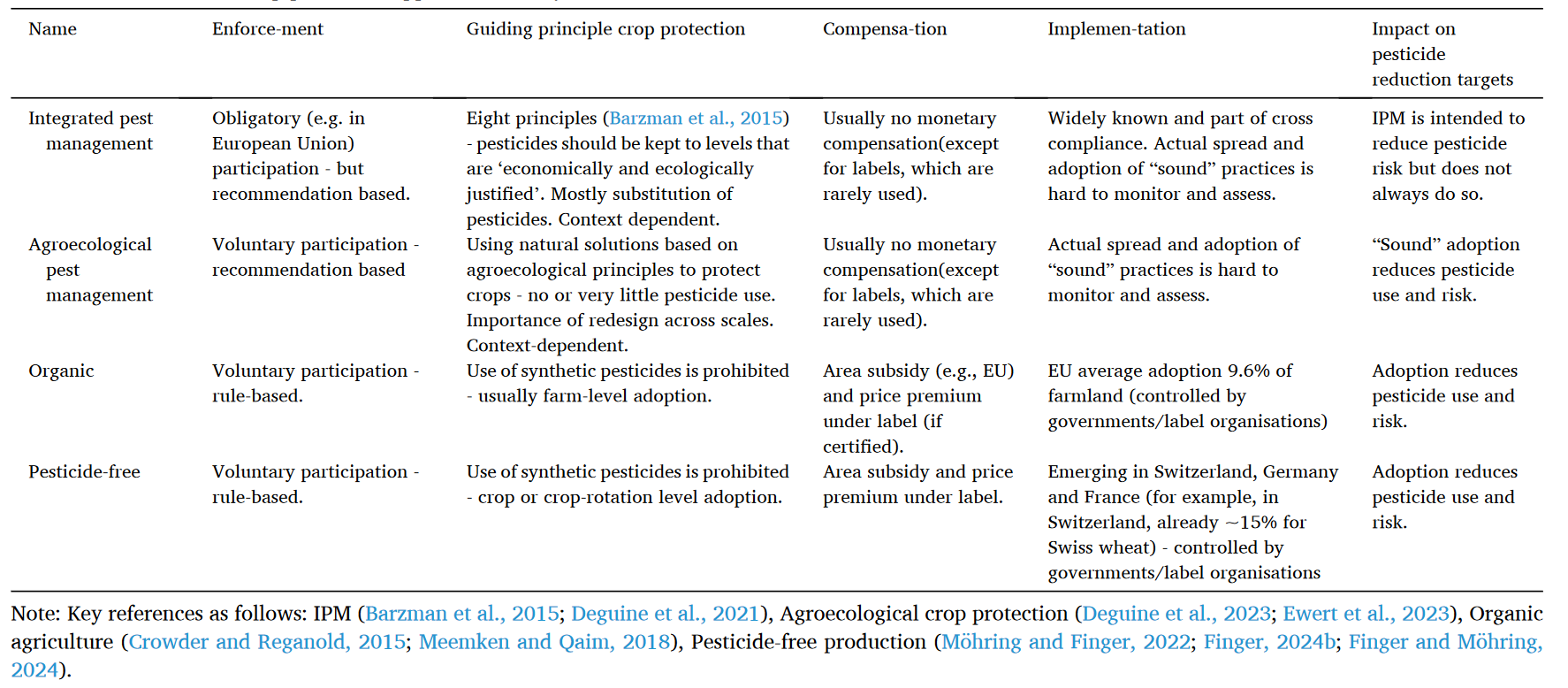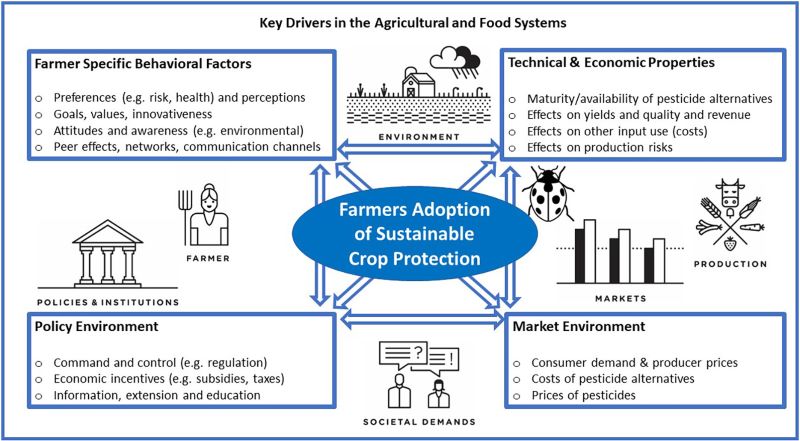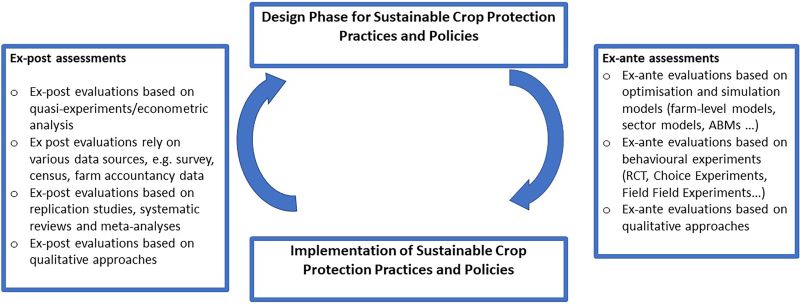01.August 2024
European countries have set ambitious targets to reduce the risks of crop protection products (Schneider et al., 2023; Finger, 2024). To meet these targets, farmers will need to apply sustainable crop protection strategies. However, it is still unclear how best to achieve this. In a recent article in Agricultural Systems (Finger et al., 2024), we analyze farmers' decision-making and policy instruments for sustainable crop protection. We summarize and extend conceptual foundations and empirical evidence. This results in important implications for research and policy.
Robert Finger, Jaap Sok , Emmanuel Ahovi , Sharmin Akter, Johan Bremmer, Silke Dachbrodt-Saaydeh, Carolien de Lauwere, Cordelia Kreft, Per Kudsk, Fatima Lambarraa-Lehnhardt, Chloe McCallum, Alfons Oude Lansink, Erwin Wauters, Niklas Möhring
What is sustainable crop protection?
There are different approaches and concepts to reduce the use and risks of pesticides, such as integrated pest management, agroecological pest management, and organic and pesticide-free (but not organic) production systems (Deguine et al., 2023; Finger and Möhring, 2024) (see Table 1).
Click to enlarge

Table 1. Overview of sustainable crop protection approaches and systems. Source: Finger et al. (2024)
The common goal of these approaches is to ensure effective plant protection and high productivity in food production, reduce negative impacts on the environment and human health, and ensure the economic viability of agriculture. This is mainly achieved through a combination of measures such as prevention, biological control, agronomic solutions (e.g. adapted crop rotations, field hygiene), technical solutions (e.g. mechanical weed control, smart farming) and the use of resistant and adapted varieties (Möhring et al., 2020). These approaches can therefore be used (alone or in combination) to achieve policy objectives, but our analysis shows that combinations and bundling of individual measures are currently not sufficiently taken into account in the design of policy instruments and analyses.
Better indicators for evaluating the application of sustainable crop protection
A key challenge in sustainable crop protection is defining implementation. Currently, most policy analyses focus on the implementation of specific measures on farms. However, risk reduction indicators are more relevant to the actual effect of policy interventions. Two important types are 1) risk-based weights for active substances, such as the Pesticide Load Indicator (Kudsk et al., 2018), and 2) context-specific risk models, such as the Risk Score (Tang et al., 2021) and the SYNOPS indicator (Strassemeyer et al., 2017)..
Ideally, we would measure the impact of crop protection decisions on environmental inputs, biodiversity, and health, and move toward outcome- and impact-based indicators. Such a shift would improve policy analysis of the effectiveness of interventions by considering both implementation and impact and would prioritize indicators of risk reduction associated with crop protection products. It could also lead to the use of (targeted) measures that are better accepted by farmers.
Better consideration of farmer behavior in research and policy
Another important starting point is to better understand behavior with regard to the use of crop protection strategies and to adapt measures accordingly. Our analysis shows that various behavioral factors influence the adoption of sustainable crop protection practices. These include economic preferences (e.g. time and risk preferences), motivations, heuristics, cognitive biases, social capital, culture, personal skills and other individual characteristics. These factors are crucial but have not yet been sufficiently explored in the analysis of sustainable crop production and policy.
Figure 1 shows the conceptual framework for farmer decision making regarding the use of crop protection products. The influencing factors can be divided into technical and economic characteristics of alternatives to crop protection products, political and market conditions and individual behavioral factors of farmers. There are interdependencies among these categories. For example, farmers' risk preferences are more relevant when sustainable practices are associated with higher risks. At the same time, the compensation required to incentivize the adoption of these practices depends on their costs.

Figure 1. Framework on Farmer adoption of sustainable crop protection approaches. Source: Finger et al. (2024)
Improved methods for analyzing the implementation of sustainable crop protection
Finally, we highlight methodological implications for research that can lead to better research to support the agricultural sector and policy. We focus on farmers' acceptance of sustainable pest management and the impact and evaluation of policy measures (Figure 2). Current methods for analyzing policy instruments often ignore important aspects such as behavioral economic factors. These are not well documented in databases such as the Farm Accountancy Data Network or in survey data. In addition, with a few exceptions such as Dueri and Mack, 2024, indicators of sustainable crop management are often missing from farm and sector models.

Figure 2. Methodological Approaches to assess Sustainable Crop Protection Practices and Related Policies in the Policy Cycle. Source: Finger et al. (2024)
Implications for policy
Our analysis has several implications for crop protection policy. First, policy should focus on the environmental and health impacts of sustainable(r) crop protection rather than simply evaluating the implementation of measures. Second, policy should consider behavioral economic factors that influence farmers' decisions. For example, policy can provide tools to mitigate the risks associated with sustainable practices and promote social interaction among farmers. This can help to increase the acceptance of sustainable crop protection. Taking behavioral factors into account can also facilitate the use of instruments such as nudges in the policy toolbox. Third, improved models and databases as well as detailed data on crop protection and pesticide use are needed for evidence-based policy making and better monitoring of results.
Project partner:
- Agricultural Economics and Policy Group, ETH Zürich, Zürich, Switzerland
- Business Economics Group, Wageningen University and Research, Wageningen, the Netherlands
- Julius Kühn-Institut, Kleinmachnow, Germany
- Aarhus University, Slagelse, Denmark
- University of Göttingen, Department of Agricultural Economics and Rural Development, Göttingen, Germany
- Queens University Belfast, United Kingdom
Funding:
This research was carried out as part of the project SUPPORT Supporting Uptake Integrated Pest Management and Low-Risk Pesticide Use, funded by the European Union's (EU) Horizon Europe research and innovation programme under Grant Agreement No. 101084527), https://he-support.eu/. The content of this article does not represent the official position of the European Union. The information and views expressed are the sole responsibility of the authors.
Original publication:
Finger, R., Sok, J., Ahovi, E., Akter, S., Bremmer, J., Dachbrodt-Saaydeh, S., de Lauwere, C. Kreft, C., Kudsk, P., Lambarraa-Lehnhardt, F., McCallum, C., Oude Lansink, A., Wauters, E., Möhring, N. (2024). Towards sustainable crop protection in agriculture: A framework for research and policy. Agricultural Systems, 219, 104037
https://doi.org/10.1016/j.agsy.2024.104037
https://www.sciencedirect.com/science/article/pii/S0308521X24001872?via%3Dihub
